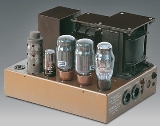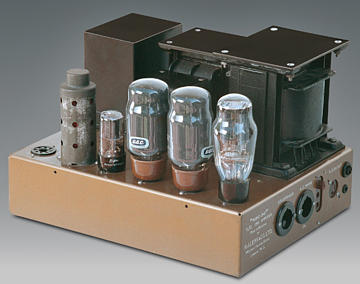
LEAK
Encyclopedia
LEAK is the brand name for high-fidelity audio equipment made by H. J. Leak & Co. Ltd, of London, England. The company was founded in 1934 by Harold Joseph Leak and was sold to the Rank Organisation in January 1969. During the 1950s and 60s, the company produced high-quality amplifiers, radio tuners, loudspeaker
s (the LEAK Sandwich
), pickups, arms and a turntable
. The sale of the business to Rank saw an expanded range of models, and considerable further development of loudspeakers, but Rank was not able to position the brand to counter competition from Japanese electronics manufacturers, so by the late 1970s electronics and speaker production ceased under the LEAK name.
During the latter part of the Second World War, the company started developing amplifiers that made extensive use of negative feedback
to achieve very high performance. This approach had been invented by Harold Black of Bell Telephone Laboratories in 1934, but it was slow to emerge as popular method for controlling amplifier performance.
valves connected as triode
s, with 26 dB feedback
applied over four stages. The amplifier has a similar topology to the Williamson amplifier
published in Wireless World
in 1947.
 In 1948, the original four-stage circuit was replaced with a three-stage design that was designated the TL/12. This amplifier had the same high performance at reduced cost, and it was responsible for establishing and securing the future of the company as a dominant player in the "hi-fi" boom of the 1950s and 60s.
In 1948, the original four-stage circuit was replaced with a three-stage design that was designated the TL/12. This amplifier had the same high performance at reduced cost, and it was responsible for establishing and securing the future of the company as a dominant player in the "hi-fi" boom of the 1950s and 60s.
Subsequent amplifiers from the company all used the same circuit topology as the TL/12, but took advantage of newer more efficient power valves and the so-called "ultra-linear
" connection of the output stage to obtain higher power output with triode-like characteristics. These amplifiers included the TL/10, TL/25, TL/12-Plus, TL/25-Plus, TL/50-Plus, and the Stereo 20, Stereo 50 and Stereo 60.
Loudspeaker
A loudspeaker is an electroacoustic transducer that produces sound in response to an electrical audio signal input. Non-electrical loudspeakers were developed as accessories to telephone systems, but electronic amplification by vacuum tube made loudspeakers more generally useful...
s (the LEAK Sandwich
LEAK Sandwich
The LEAK Sandwich was an innovative loudspeaker design introduced by the English hi-fi company H. J. Leak & Co. in 1961. Harold Leak engaged Don Barlow, who had devised a way of making the cone of the loudspeaker from expanded polystyrene foam sandwiched between two sheets of aluminium foil...
), pickups, arms and a turntable
Phonograph
The phonograph record player, or gramophone is a device introduced in 1877 that has had continued common use for reproducing sound recordings, although when first developed, the phonograph was used to both record and reproduce sounds...
. The sale of the business to Rank saw an expanded range of models, and considerable further development of loudspeakers, but Rank was not able to position the brand to counter competition from Japanese electronics manufacturers, so by the late 1970s electronics and speaker production ceased under the LEAK name.
Early days
The company initially focussed on provision of amplifiers for public address systems and theatres, with only a few staff. Typical designs used were similar to those found in the Partridge Public Address Manuals of the time, which used Osram's DA30 power triodes in push-pull for 45 watts output.During the latter part of the Second World War, the company started developing amplifiers that made extensive use of negative feedback
Negative feedback
Negative feedback occurs when the output of a system acts to oppose changes to the input of the system, with the result that the changes are attenuated. If the overall feedback of the system is negative, then the system will tend to be stable.- Overview :...
to achieve very high performance. This approach had been invented by Harold Black of Bell Telephone Laboratories in 1934, but it was slow to emerge as popular method for controlling amplifier performance.
Point One
In September 1945 the company released the first of the "Point One" series of amplifiers, so named because the total harmonic distortion was 0.1% at rated output. This represented a major leap forward in accepted standards for high-performance amplifiers (with 2% distortion generally considered acceptable at the time). This first "Point One" amplifier was known as the Type 15, and produced 15 watts output, at 0.1% distortion, using push-pull KT66KT66
The KT66 is a beam tetrode/kinkless tetrode vacuum tube for audio amplification.KT66 is the designator for a vacuum tube introduced by Marconi-Osram Valve Co. Ltd. of Britain in 1937....
valves connected as triode
Triode
A triode is an electronic amplification device having three active electrodes. The term most commonly applies to a vacuum tube with three elements: the filament or cathode, the grid, and the plate or anode. The triode vacuum tube was the first electronic amplification device...
s, with 26 dB feedback
Feedback
Feedback describes the situation when output from an event or phenomenon in the past will influence an occurrence or occurrences of the same Feedback describes the situation when output from (or information about the result of) an event or phenomenon in the past will influence an occurrence or...
applied over four stages. The amplifier has a similar topology to the Williamson amplifier
Williamson amplifier
A Williamson amplifier refers to a type of vacuum tube amplifier whose circuit design is similar to that originally published by D.T.N. Williamson.- Explanation :...
published in Wireless World
Wireless World
Wireless World was the pre-eminent British magazine for radio and electronics enthusiasts. It was one of the very few "informal" journals which were tolerated as a professional expense.- History :...
in 1947.

Subsequent amplifiers from the company all used the same circuit topology as the TL/12, but took advantage of newer more efficient power valves and the so-called "ultra-linear
Ultra-Linear
Ultra-linear is a term used to describe a type of electronic circuit that is used to couple a tetrode or pentode vacuum-tube to a load ....
" connection of the output stage to obtain higher power output with triode-like characteristics. These amplifiers included the TL/10, TL/25, TL/12-Plus, TL/25-Plus, TL/50-Plus, and the Stereo 20, Stereo 50 and Stereo 60.

